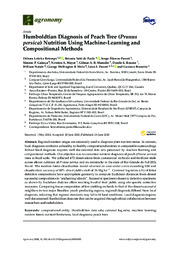Humboldtian Diagnosis of Peach Tree (Prunus persica) Nutrition Using Machine-Learning and Compositional Methods.
Humboldtian Diagnosis of Peach Tree (Prunus persica) Nutrition Using Machine-Learning and Compositional Methods.
Autoria: BETEMPS, D. L.; PAULA, B. V. de; PARENT, S.-E.; GALARÇA, S. P.; MAYER, N. A.; MARODIN, G. A. B.; ROZANE, D. E.; NATALE, W.; MELO, G. W. B. de; PARENT, L. E.; BRUNETTO, G.
Resumo: Regional nutrient ranges are commonly used to diagnose plant nutrient status. In contrast, local diagnosis confronts unhealthy to healthy compositional entities in comparable surroundings. Robust local diagnosis requires well-documented data sets processed by machine learning and compositional methods. Our objective was to customize nutrient diagnosis of peach (Prunus persica) trees at local scale. We collected 472 observations from commercial orchards and fertilizer trials across eleven cultivars of Prunus persica and six rootstocks in the state of Rio Grande do Sul (RS), Brazil. The random forest classification model returned an area under curve exceeding 0.80 and classification accuracy of 80% about yield cutoff of 16 Mg ha-1 Centered log ratios (clr) of foliar defective compositions have appropriate geometry to compute Euclidean distances from closest successful compositions in 'enchanting islands'. Successful specimens closest to defective specimens as shown by Euclidean distance allow reaching trustful fruit yields using site-specific corrective measures. Comparing tissue composition of low-yielding orchards to that of the closest successful neighbors in two major Brazilian peach-producing regions, regional diagnosis diered from local diagnosis, indicating that regional standards may fail to fit local conditions. Local diagnosis requires well-documented Humboldtian data sets that can be acquired through ethical collaboration between researchers and stakeholders.
Ano de publicação: 2020
Tipo de publicação: Artigo de periódico
Unidade: Embrapa Clima Temperado
Palavras-chave: Porta Enxerto, Prunus, Pêssego
Observações
1 - Por padrão são exibidas publicações dos últimos 20 anos. Para encontrar publicações mais antigas, configure o filtro ano de publicação, colocando o ano a partir do qual você deseja encontrar publicações. O filtro está na coluna da esquerda na busca acima.
2 - Para ler algumas publicações da Embrapa (apenas as que estão em formato ePub), é necessário ter, no celular ou computador, um desses softwares gratuitos. Sistemas Android: Google Play Livros; IOS: iBooks; Windows e Linux: software Calibre.
Acesse outras publicações
Acesse a Base de Dados da Pesquisa Agropecuária (BDPA) para consultar o acervo completo das bibliotecas da Embrapa.

